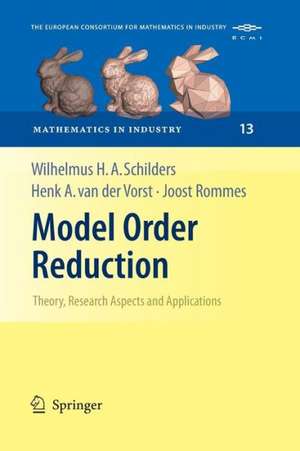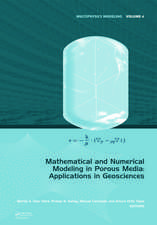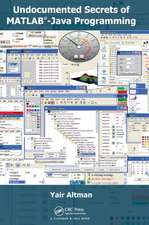Model Order Reduction: Theory, Research Aspects and Applications: Mathematics in Industry, cartea 13
Editat de Wilhelmus H. Schilders, Henk A. van der Vorst, Joost Rommesen Limba Engleză Paperback – 24 sep 2014
| Toate formatele și edițiile | Preț | Express |
|---|---|---|
| Paperback (1) | 953.35 lei 6-8 săpt. | |
| Springer Berlin, Heidelberg – 24 sep 2014 | 953.35 lei 6-8 săpt. | |
| Hardback (1) | 957.62 lei 6-8 săpt. | |
| Springer Berlin, Heidelberg – 26 aug 2008 | 957.62 lei 6-8 săpt. |
Din seria Mathematics in Industry
- 20%
 Preț: 567.11 lei
Preț: 567.11 lei - 18%
 Preț: 1045.68 lei
Preț: 1045.68 lei - 15%
 Preț: 650.86 lei
Preț: 650.86 lei - 13%
 Preț: 388.27 lei
Preț: 388.27 lei - 18%
 Preț: 1010.48 lei
Preț: 1010.48 lei - 18%
 Preț: 1247.26 lei
Preț: 1247.26 lei - 18%
 Preț: 982.87 lei
Preț: 982.87 lei - 15%
 Preț: 646.62 lei
Preț: 646.62 lei - 18%
 Preț: 959.50 lei
Preț: 959.50 lei - 15%
 Preț: 642.36 lei
Preț: 642.36 lei - 15%
 Preț: 643.34 lei
Preț: 643.34 lei - 18%
 Preț: 1020.74 lei
Preț: 1020.74 lei - 18%
 Preț: 962.81 lei
Preț: 962.81 lei - 18%
 Preț: 790.28 lei
Preț: 790.28 lei - 24%
 Preț: 825.71 lei
Preț: 825.71 lei -
 Preț: 499.81 lei
Preț: 499.81 lei - 15%
 Preț: 642.03 lei
Preț: 642.03 lei - 18%
 Preț: 1234.46 lei
Preț: 1234.46 lei - 15%
 Preț: 640.88 lei
Preț: 640.88 lei - 18%
 Preț: 1238.56 lei
Preț: 1238.56 lei - 15%
 Preț: 634.49 lei
Preț: 634.49 lei - 15%
 Preț: 642.18 lei
Preț: 642.18 lei - 15%
 Preț: 661.02 lei
Preț: 661.02 lei - 24%
 Preț: 793.13 lei
Preț: 793.13 lei - 15%
 Preț: 648.42 lei
Preț: 648.42 lei - 15%
 Preț: 653.79 lei
Preț: 653.79 lei - 24%
 Preț: 1046.72 lei
Preț: 1046.72 lei - 18%
 Preț: 1399.24 lei
Preț: 1399.24 lei - 18%
 Preț: 943.25 lei
Preț: 943.25 lei
Preț: 953.35 lei
Preț vechi: 1162.61 lei
-18% Nou
Puncte Express: 1430
Preț estimativ în valută:
182.42€ • 190.46$ • 150.98£
182.42€ • 190.46$ • 150.98£
Carte tipărită la comandă
Livrare economică 05-19 aprilie
Preluare comenzi: 021 569.72.76
Specificații
ISBN-13: 9783642427732
ISBN-10: 3642427731
Pagini: 484
Ilustrații: XI, 471 p.
Dimensiuni: 155 x 235 x 25 mm
Greutate: 0.67 kg
Ediția:2008
Editura: Springer Berlin, Heidelberg
Colecția Springer
Seriile Mathematics in Industry, The European Consortium for Mathematics in Industry
Locul publicării:Berlin, Heidelberg, Germany
ISBN-10: 3642427731
Pagini: 484
Ilustrații: XI, 471 p.
Dimensiuni: 155 x 235 x 25 mm
Greutate: 0.67 kg
Ediția:2008
Editura: Springer Berlin, Heidelberg
Colecția Springer
Seriile Mathematics in Industry, The European Consortium for Mathematics in Industry
Locul publicării:Berlin, Heidelberg, Germany
Public țintă
ResearchCuprins
Basic Concepts.- to Model Order Reduction.- Linear Systems, Eigenvalues, and Projection.- Theory.- Structure-Preserving Model Order Reduction of RCL Circuit Equations.- A Unified Krylov Projection Framework for Structure-Preserving Model Reduction.- Model Reduction via Proper Orthogonal Decomposition.- PMTBR: A Family of Approximate Principal-components-like Reduction Algorithms.- A Survey on Model Reduction of Coupled Systems.- Space Mapping and Defect Correction.- Modal Approximation and Computation of Dominant Poles.- Some Preconditioning Techniques for Saddle Point Problems.- Time Variant Balancing and Nonlinear Balanced Realizations.- Singular Value Analysis and Balanced Realizations for Nonlinear Systems.- Research Aspects and Applications.- Matrix Functions.- Model Reduction of Interconnected Systems.- Quadratic Inverse Eigenvalue Problem and Its Applications to Model Updating — An Overview.- Data-Driven Model Order Reduction Using Orthonormal Vector Fitting.- Model-Order Reduction of High-Speed Interconnects Using Integrated Congruence Transform.- Model Order Reduction for MEMS: Methodology and Computational Environment for Electro-Thermal Models.- Model Order Reduction of Large RC Circuits.- Reduced Order Models of On-Chip Passive Components and Interconnects, Workbench and Test Structures.
Notă biografică
Wil Schilders received the MSc degree in pure and applied mathematics from Nijmegen University in 1978, and a PhD in numerical analysis from Trinity College Dublin in 1980. Since 1980, he has been with Philips Electronics, where he developed algorithms for semiconductor device simulation, electronic circuit simulation, and electromagnetics problems. He wrote two volumes on the numerical simulation of semiconductor devices, and published a special volume on Numerical Methods in Electromagnetics. Since 1999, he is part-time professor in numerical analysis for industry at Eindhoven University of Technology. He developed a novel method known as the Schilders factorization for the solution of indefinite linear systems. Since more than a decade, his interest is in model order reduction, and he is a frequent organizer of workshops and symposia on this topic. Currently, he is with NXP Semiconductors, heading the Mathematics group.
Henk van der Vorst is a leading expert in numerical linear algebra, in particular in iterative methods for linear systems and eigenproblems. The techniques developed and used in these areas are of very high interest in model order reduction. Van der Vorst was the (co-) author of novel and highly important techniques, including incomplete decompositions, Bi-CGSTAB, and the Jacobi-Davidson method. The Bi-CGSTAB paper was the most cited paper in mathematics of the 1990’s according to ISI in 2000. For the Jacobi-Davidson method he received, together with co-author Sleijpen a SIAG-LA Award for the best paper in numerical linear algebra over a three year period. Van der Vorst is Editor in Chief of the SIAM Journal SIMAX and he is member of the Netherlands Royal Academy of Sciences.
Joost Rommes received the M.Sc. degree in computational science, the M.Sc.
degree in computer science, and the Ph.D. degree in mathematics from Utrecht
University, Utrecht, The Netherlands, in 2002, 2003, and 2007, respectively. Duringhis PhD studies he worked on eigensolution methods with applications in model order reduction. Some of his developed methods are now used in software for circuit simulation and power system analysis. Joost Rommes currently works at NXP Semiconductors on model order reduction. In the electronics industry, an increase in complexity at transistor level leads to much large models that can not be simulated without accurate reduction techniques. Due to specific properties of the models, there is also need for different reduction techniques that can deal with these properties. This book provides a wide range of reduction techniques.
Henk van der Vorst is a leading expert in numerical linear algebra, in particular in iterative methods for linear systems and eigenproblems. The techniques developed and used in these areas are of very high interest in model order reduction. Van der Vorst was the (co-) author of novel and highly important techniques, including incomplete decompositions, Bi-CGSTAB, and the Jacobi-Davidson method. The Bi-CGSTAB paper was the most cited paper in mathematics of the 1990’s according to ISI in 2000. For the Jacobi-Davidson method he received, together with co-author Sleijpen a SIAG-LA Award for the best paper in numerical linear algebra over a three year period. Van der Vorst is Editor in Chief of the SIAM Journal SIMAX and he is member of the Netherlands Royal Academy of Sciences.
Joost Rommes received the M.Sc. degree in computational science, the M.Sc.
degree in computer science, and the Ph.D. degree in mathematics from Utrecht
University, Utrecht, The Netherlands, in 2002, 2003, and 2007, respectively. Duringhis PhD studies he worked on eigensolution methods with applications in model order reduction. Some of his developed methods are now used in software for circuit simulation and power system analysis. Joost Rommes currently works at NXP Semiconductors on model order reduction. In the electronics industry, an increase in complexity at transistor level leads to much large models that can not be simulated without accurate reduction techniques. Due to specific properties of the models, there is also need for different reduction techniques that can deal with these properties. This book provides a wide range of reduction techniques.
Textul de pe ultima copertă
The goal of this book is three-fold: it describes the basics of model order reduction and related aspects.
In numerical linear algebra, it covers both general and more specialized model order reduction techniques for linear and nonlinear systems, and it discusses the use of model order reduction techniques in a variety of practical applications. The book contains many recent advances in model order reduction, and presents several open problems for which techniques are still in development. It will serve as a source of inspiration for its readers, who will discover that model order reduction is a very exciting and lively field.
In numerical linear algebra, it covers both general and more specialized model order reduction techniques for linear and nonlinear systems, and it discusses the use of model order reduction techniques in a variety of practical applications. The book contains many recent advances in model order reduction, and presents several open problems for which techniques are still in development. It will serve as a source of inspiration for its readers, who will discover that model order reduction is a very exciting and lively field.
Caracteristici
High-quality book on industrial mathematics by one of the major research consortia in this field Includes supplementary material: sn.pub/extras












